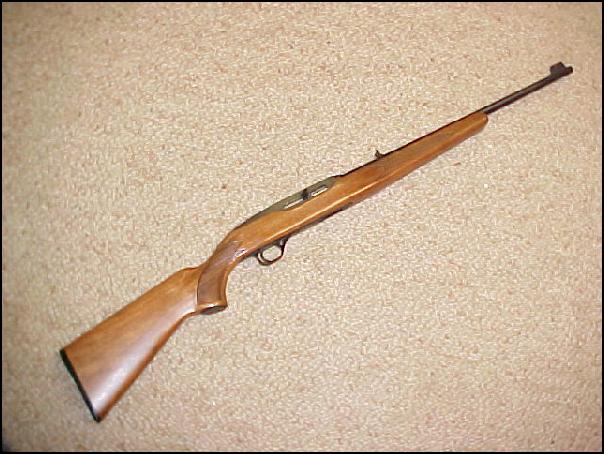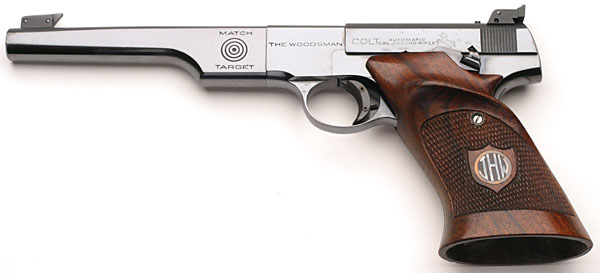Just another reason on why Ruger beat the pants off of Winchester in the 22 Semi Auto market. I.E. Too little & too late! Nonetheless it’s a nice little gun in its way!



As you can see the rotary magazine of the 10/22. Helps preserve the clean lines that this gun does not have with the extended magazine. Also it will not snag on things either when carrying it.














.40-65 Winchester
| .40-65 Winchester | ||||||||||||||||
|---|---|---|---|---|---|---|---|---|---|---|---|---|---|---|---|---|
| Type | Rifle | |||||||||||||||
| Place of origin | USA | |||||||||||||||
| Specifications | ||||||||||||||||
| Bullet diameter | .406 in (10.3 mm) | |||||||||||||||
| Neck diameter | .423 in (10.7 mm) | |||||||||||||||
| Shoulder diameter | .560 in (14.2 mm) | |||||||||||||||
| Base diameter | .504 in (12.8 mm) | |||||||||||||||
| Rim diameter | .604 in (15.3 mm) | |||||||||||||||
| Case length | 2.1 in (53 mm) | |||||||||||||||
| Overall length | 2.48 in (63 mm) | |||||||||||||||
| Rifling twist | 1:20 to 1:26 | |||||||||||||||
| Primer type | large rifle | |||||||||||||||
| Ballistic performance | ||||||||||||||||
|
||||||||||||||||
| Source(s): Barnes & Amber | ||||||||||||||||
The .40-65 Winchester (also called the .40-65 Winchester and Marlin)[1] was an American rifle cartridge.
Introduced in 1887 for the Winchester Model 1886, and available in Winchester single shots and in the Marlin Model 1895, it was “a further effort to put more steam” in repeating rifle cartridges.[2]
In the modern era, the cartridge has gained favor for metallic silhouette shooting and Black Powder Cartridge Rifle matches where is serves as a low-recoil alternative to the common 45-70.[3][4]
It was commercially available in black and smokeless varieties until around 1935, and can be handloaded by reforming .45-70 brass.[2]
Nomenclature
The nomenclature of the period was based on several properties of the cartridge:
- .40: nominal caliber in inches: 0.40 inches (10.2 mm); actual caliber was .406 in ( mm)[5]
- 65 : weight of propellant (black powder) charge, in grains: 65 grains (4.2 g)
Cute Little Turd!





| AMT AutoMag II | |
|---|---|
| Type | Semi-automatic pistol |
| Place of origin | United States |
| Production history | |
| Manufacturer | Arcadia Machine and Tool |
| Unit cost | $406 MSRP |
| Produced | 1987 |
| Specifications | |
| Weight | 32 oz (910 g) |
| Barrel length | 6 in (150 mm), 4.5 in (110 mm), 3.375 in (85.7 mm) (Compact Model) |
|
|
|
| Cartridge | .22 Winchester Magnum Rimfire |
| Barrels | 1 6 grooves, right hand twist |
| Feed system | 9 round detachable magazine 7 round detachable magazine (Compact Model) |
| Sights | White outline Millet adjustable sights (until late 1993) Adjustable 3 dot system (since late 1993)[1] |
The AMT AutoMag II is a semiautomatic handgun chambered in .22 WMR, that was manufactured by Arcadia Machine and Tool from 1987 until 1999[2] It is currently manufactured by High Standard.[3]
Design
There were a number of engineering challenges to overcome in designing an autoloading .22 WMR handgun such as extraction problems.
The extraction problems stem from the fact that the slow burning rifle powder of the .22 WMR cartridge develops a late peak pressure.
This can cause the case mouth to expand and jam in the chamber when fired from a handgun. AMT overcame this issue by drilling 18 holes at 90 degrees to the chamber.
A sleeve was then welded over the chamber; providing a tiny amount of clearance for the excess gas to escape from the first set of holes on back to the second set, thereby relieving the pressure enough to prevent the case from sticking.[4]
The stainless steel slide has a large cutout over the barrel, similar to the Beretta M9, to facilitate better cooling and ejection of the spent brass casing.
(More likely it is simply to reduce the moving mass of the slide to allow for the blow-back operation).
The stainless steel construction throughout makes rust a non-issue.
Again I want to thank all of our Wonderful Readers out there! Gentlemen is a small token of my appreciation below!









Preview YouTube video The first Hickok45 video ever with a .50 BMG Barrett
Preview YouTube video Springfield Trapdoor
Preview YouTube video Classic Single Shot Rifles
Preview YouTube video The Mauser 98 Project — Interview with Larry Potterfield
Preview YouTube video The most unique Mauser rifle ever made


This just goes to show me that on the subject of guns. That it is almost impossible for me to know “everything” about guns. Since this is the 1st I have heard of this Colt Pistol!
Grumpy




Colt WoodsmanFrom Wikipedia, the free encyclopedia
| Colt Woodsman | |
|---|---|

An early first series Colt Woodsman pistol and magazine.
|
|
| Type | Semi-automatic pistol |
| Place of origin | United States |
| Production history | |
| Designer | John Browning |
| Manufacturer | Colt’s Manufacturing Company |
| Produced | 1915–1977 |
| No. built | More than 690,000 [1] |
| Specifications | |
| Weight | Approx: 1.875 Lbs |
| Barrel length | 4.5, 6, or 6.625 inches. |
|
|
|
| Cartridge | .22 Long Rifle |
| Action | Semi-automatic |
The Colt Woodsman is a semi-automatic sporting pistol manufactured by the American Colt’s Manufacturing Company from 1915 to 1977. It was designed by John Moses Browning.[2]
The frame design changed over time, in three distinct series: series one being 1915–1941, series two 1947–1955, and series three being 1955–1977.
Contents
Design
The Colt Woodsman sprang from a design by John Moses Browning and was refined by gunsmiths and designers at Colt’s before its introduction in 1915.[3]
Without the constraints of the US Government interfering with his design, Browning developed the Woodsman with a short slide, no grip safety and no hammer.
These features were in place on his Model 1903 and 1911 designs, but a handgun for the civilian market did not require them.[4]
Variants and versions
There are three series of the Colt Woodsman and each series had three models: Target, Sport and Match Target.[3]
First Series 1915-1941
The Target Model was the base model of the Woodsman and featured a 6″ barrel with adjustable front and rear sights.[3]
The Sport Model was designed as a field sidearm for hiking and camping in 1933 and had a 4.5″ barrel. Original versions were made with a fixed front sight in the first series, but by the latter half of production, an adjustable sight was available.[3]
The Match Target Model debuted in 1938 and featured a heavier barrel with a one piece wrap-around grip known as the “elephant ear.”[5] A “Bullseye” Icon was rollmarked into the slide lending the nickname “Bullseye Match Target.”[3]
In 1941 as the US entered World War II, Colt ceased civilian production of the Woodsman but delivered 4000 Match Target models to the US Government as late as 1945.[6] These pistols had a plastic one piece grip and were marked “Property US Government,” but appeared on the surplus market after the war.[4]
Second Series 1947-1955
Colt resumed production of the Woodsman in 1947. The three Models remained the same, but were built on a longer heavier frame and had a magazine safety, automatic slide stop and magazine release located at the rear of the trigger guard.[3]
Special versions were made for the United States Marine Corps (100 Match Target Models and 2500 Sport Models); United States Air Force (925 Target Models) and 75 Match Target Models for the United States Coast Guard.
The Air Force models had no special markings and most were sold as surplus through the Director of Civilian Marksmanship Program. The bulk of the Marine and Coast Guard versions were destroyed and sold as scrap metal.[3]
Third Series 1955-1977
Colt changed the design of the Woodsman in 1955. The three Models remained the same, but the markings, grips and sights underwent slight changes.
The most significant was relocating the magazine release from the rear of the trigger guard to the heel of the grip as on the first series.[3]
Colt also introduced new models, such as the less expensive Challenger and Huntsman Models equipped with fixed sights. From 1960 walnut stocks with a thumb rest were optional, in place of the standard black plastic stocks.[1]
Literary references to the Colt Woodsman
Screenwriter and pulp fiction author Raymond Chandler:
“They came out at me, almost side by side, from the dressing room beside the wall bed – two of them – with guns. The tall one was grinning. He had his hat low on his forehead and he had a wedge-shaped face that ended in a point, like the bottom of the ace of diamonds. He had moist eyes and a nose so bloodless that it might have been made of white wax. His gun was a Colt Woodsman with a long barrel and the front sight filed off. That meant he thought he was good.”[7] (emphasis added)
Novelist Ernest Hemingway:
The rifle and the pistol are still the equalizer when one man is more of a man than another, and if…he is really smart…he will get a permit to carry one and then drop around to Abercrombie and Fitch and buy himself a .22 caliber Colt automatic pistol, Woodsman model, with a five-inch barrel and a box of shells. I advise him to get lubricated hollow points to avoid jams and to ensure a nice expansion on the bullet. He might even get several boxes and practice a little…
Now standing in one corner of a boxing ring with a .22 caliber Colt automatic pistol, shooting a bullet weighing only 40 grains and with a striking energy of 51 foot pounds at 25 feet from the muzzle, I will guarantee to kill either [boxer] Gene [Tunney] or Joe Louis before they get to me from the opposite corner. This is the smallest caliber pistol cartridge made; but it is also one of the most accurate and easy to hit with, since the pistol has no recoil. I have killed many horses with it, cripples and bear baits, with a single shot, and what will kill a horse will kill a man. I have hit six dueling silhouettes in the head with it at regulation distance in five seconds. It was this type of pistol that Millen boys’ colleague, Abe Faber, did all his killings with. Yet this same pistol bullet fired at point blank range will not dent a grizzly’s skull, and to shoot a grizzly with a .22 caliber pistol would simply be one way of committing suicide.” [8] (emphasis added)
Novelist Kyril Bonfiglioli:
“We chattered on in a desultory way but I found it harder to concentrate on the prettier points of fish-frying. Texas businessmen doubtless often carry pistols but I found it hard to believe that they would favour the inconvenient length of a Colt’s Woodsman, which is a small calibre, long-barrelled semi-automatic used only for target shooting and, more rarely, by professional killers who know they can plant its small bullet in just the right place. As a handy weapon of self-defence for the ordinary citizen, it simply doesn’t exist. Moreover, Texas businessmen, I felt sure, would be unlikely to house their pistols in Bryson rapid-release spring-clips.” (emphasis added)
See also
References
- ^ Jump up to:a b Hacker, Rick (4 March 2011). “Colt Woodsman Target Model”. American Rifleman. National Rifle Association of America. Retrieved 25 March 2015.
This is yet another classic firearm from John M. Browning, assisted by Colt employees George H. Tansley and F.C. Chadwick.
- Jump up^ Campbell, Dave (28 October 2010). “Colt Woodsman”. Shooting Illustrated. National Rifle Association. Retrieved 26 March2015.
- ^ Jump up to:a b c d e f g h Rayburn, Bob (2007). Rick Sapp, ed. Standard Catalog of Colt Firearms. Iola, Wisconsin: F+W Media, Inc. pp. 171–179. ISBN 0-89689-534-3.
- ^ Jump up to:a b Miller, David (2006). The History of Browning Firearms. Lyons Press. pp. 50–52. ISBN 978-1-59228-910-3.
- Jump up^ Emanuele, Rasti. “Colt Woodsman”. GunsCollecting.com (in Italian). Bernardino Carducci. Retrieved 26 March 2015.
- Jump up^ Eger, Chris (22 April 2014). “The Colt Woodsman: A most pined after plinking pistol”. Guns.com. Retrieved 26 March 2015.
- Jump up^ Chandler, 1939
- Jump up^ Hemingway, 1938, p. 189
Cited in footnotes[edit]
- Chandler, Raymond T. 2002. ‘Trouble is My Business’ originally published in Dime Detective Magazine, August, 1939. Republished in Raymond Chandler: Collected Stories. 2002. Everyman’s Library, Alfred A. Knopf, New York. P. 1009.
- Hemingway, Ernest. 1938. ‘My Pal the Gorilla Gargantua’ in Hemingway on Hunting ed. Sean Hemingway. The Lyons Press, Connecticut. p. 189 Originally published in Ken Magazine, July 28, 1938









